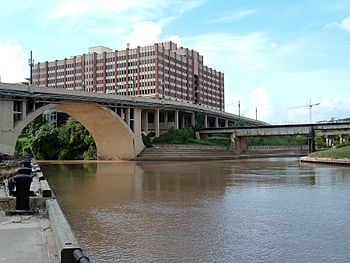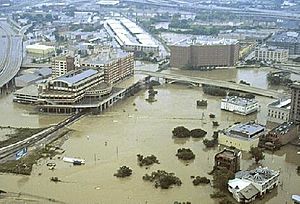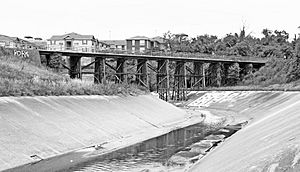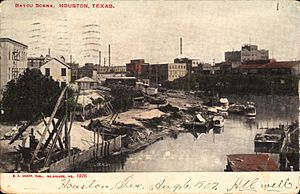White Oak Bayou facts for kids
Quick facts for kids White Oak Bayou |
|
|---|---|

White Oak Bayou and Buffalo Bayou at Allen's Landing, with the University of Houston–Downtown in the distance.
|
|
| Country | |
| County | Harris |
| City | |
| Physical characteristics | |
| Main source | Drainage ditch Jersey Village, Texas 29°53′14″N 95°35′07″W / 29.8871°N 95.5853°W |
| River mouth | Buffalo Bayou Allen's Landing 29°45′54″N 95°21′31″W / 29.76510°N 95.35848°W |
| Length | 25 miles (40 km) |
| Basin features | |
| Basin size | 111 square miles (290 km2) |
| Population | 430,000 |
| Tributaries |
|
White Oak Bayou is a slow-moving river located in Houston, Texas. It is a major tributary (a smaller stream that flows into a larger one) of Buffalo Bayou, which is the city's main waterway. White Oak Bayou starts near Texas State Highway 6 and U.S. Highway 290. It then winds southeast for about 25 miles (40 km) until it joins Buffalo Bayou in Downtown.
This river acts like a "greenway," connecting Downtown Houston to several neighborhoods. These include the Houston Heights, Oak Forest, Garden Oaks, and Inwood Forest. Most of White Oak Bayou flows through busy, developed areas. Its watershed (the area of land where all the water drains into the bayou) covers about 111 square miles (290 km2). More than 430,000 people live in this area.
What is the White Oak Bayou Watershed?
The White Oak Bayou watershed collects water from northwest Harris County. It also includes the city of Jersey Village and parts of Houston. This watershed covers about 111 square miles (290 km2). It has three main streams: White Oak Bayou, Little White Oak Bayou, and Cole Creek. Other important streams, like Vogel Creek and Brickhouse Gully, also feed into it. In total, there are about 151 miles (243 km) of open streams in the White Oak Bayou watershed.
Some Wildlife can be found in undeveloped areas throughout the watershed. Special areas have been set aside or created for wildlife in large basins built to hold stormwater. However, there isn't much natural wildlife habitat left along the parts of White Oak Bayou and its smaller streams that flow through cities.
History of White Oak Bayou
The first Port of Houston was located where White Oak Bayou meets Buffalo Bayou. This spot is in what is now downtown Houston, near the University of Houston–Downtown. This historic area is called "Allen's Landing." It is known as the official birthplace of Houston, Texas. Today, Allen's Landing is a historical city park.
Near a curve in White Oak Bayou, where Houston's First and Sixth wards meet, is Olivewood Cemetery. This historic 6-acre (24,000 m2) cemetery is the resting place for many freed slaves and early black residents of Houston. It was started in 1877. It is the oldest graveyard for African-Americans in the Houston area.

In June 2001, Tropical Storm Allison brought very heavy rainfall. Much of this rain fell over the White Oak Bayou watershed. The bayou overflowed its banks, causing significant flooding in the area. Its smaller stream, Little White Oak Bayou, also experienced severe flooding.
Parks and Trails Along the Bayou
The West White Oak Bayou Trail runs along the banks of the bayou. It follows T. C. Jester Boulevard from 11th Street to Antoine Street. This trail is about 7.4-mile (11.9 km) long. It is mostly made of concrete and asphalt, perfect for bicyclists and people walking. The trail passes through several parks and has lights and railings in some spots. In 2006, the Houston Press newspaper called the West White Oak Bayou Trail the best bike path in Houston.

You can connect to the West White Oak Bayou Trail from other paths. These include the Central Business District Access On-street Bikeway at 11th Street and Ella Boulevard. You can also reach it from the West Houston On-street Bikeway at 34th Street, Du Barry Lane, 43rd Street, Carleen Road, and Pinemont Drive.
Just north of downtown Houston, near White Oak Park, the bayou banks have been cleaned up. A swampy area has been restored, which is a great spot for birdwatching. Birds like the yellow-crowned night heron and green heron build their nests there. Many eastern woodland birds also live in and around the park. The White Oak Bayou Association is a non-profit group. It works to protect, restore, and care for wildlife habitats along the bayou.
Between 18th and 11th Streets along the bayou, there is a special group of trees. These trees were planted by an organization called Trees For Houston. This "Tribute Grove" lets people plant a tree on the bayou's banks to remember special people or events. Since 1997, Trees For Houston has planted 1,494 trees in Tribute Groves in the area.


